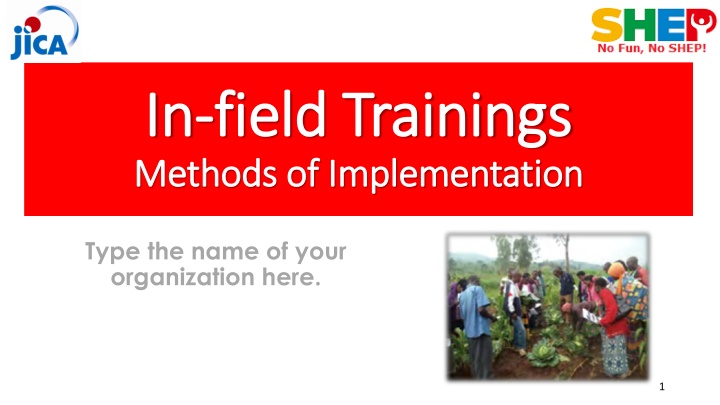
Effective Field Training Methods for Agricultural Skill Development
Enhance farmer skills and knowledge through demand-driven field trainings focusing on practical activities like crop selection, calendar making, and skill acquisition. Learn about the objectives, implementation tips, and advantages of this approach.
Download Presentation

Please find below an Image/Link to download the presentation.
The content on the website is provided AS IS for your information and personal use only. It may not be sold, licensed, or shared on other websites without obtaining consent from the author. If you encounter any issues during the download, it is possible that the publisher has removed the file from their server.
You are allowed to download the files provided on this website for personal or commercial use, subject to the condition that they are used lawfully. All files are the property of their respective owners.
The content on the website is provided AS IS for your information and personal use only. It may not be sold, licensed, or shared on other websites without obtaining consent from the author.
E N D
Presentation Transcript
In In- -field Trainings field Trainings Methods of Implementation Methods of Implementation Type the name of your organization here. 1
WHERE ARE WE?: WHERE ARE WE?: In In- -field Trainings field Trainings in SHEP s 4 Steps in SHEP s 4 Steps 4 Steps Activities 1. Share goal with farmers. Sensitization Workshop Participatory Baseline Survey (optional) Stakeholder Forum Market Survey Target Crop Selection Crop Calendar Making In-field trainings 2. Farmers awareness is raised. 3 . Farmers make decisions. 4. Farmers acquire skills. In-field Trainings are where the farmers acquire new skills and knowledge. Follow-up and monitoring (including Participatory Endline Survey) 2
PART 1: CONCEPT PART 1: CONCEPT 3
WHY?: WHY?: Objectives of In Objectives of In- -field Training field Training In-field Trainings are designed to teach practical skills and knowledge for producing the target crops the farmers have chosen. It is a demand-driven training. 4
WHAT?: WHAT?: Outline of In Outline of In- -field Training field Training The extension staff organizes training sessions where the target farmers learn skills, techniques and knowledge necessary for the production of the target crops. The training should be practical and conducted at the farmers fields or in their vicinity with ample demonstrations and exercises. 5
HOW?: HOW?: Key Key I Implementation Tips mplementation Tips The training should address the needs of the farmers. Spend more time where farmers need more training and spend less time if the farmers are already familiar with the topics. Raising Motivation 6
HOW?: HOW?: Key The training should be conducted using easy-to- understand training materials. Key I Implementation Tips mplementation Tips Raising Motivation The training should be conducted truly by a demand- driven approach. Raising Motivation 7
Advantage of Demand Advantage of Demand- -driven Training The farmers adoption rate of the new techniques would be significantly higher than supply-driven trainings. driven Training 8
Mitigating Asymmetric Information Mitigating Asymmetric Information Providing In-field Training, which is a demand-driven training, mitigates information gaps between farmers and market stakeholders. 9
PART 2 PART 2: PRACTICE : PRACTICE 10
STEP: STEP: Implementation Procedures Implementation Procedures (Preparation) The extension staff should learn knowledge and skills necessary for teaching farmers. If they need more training, Training of Trainers (TOT) for extension staff before training for farmers should be conducted. The extension staff organizes training sessions composed of lectures, exercises and demonstrations for each topic using effective teaching materials. [Tip!] Invite the members spouses to the training if they are engaged in horticulture production. The topics of the training should exactly match the needs of the target crop production and farmers capacity development needs. The training topics can be categorized into three areas: (1) general horticultural crops production and post-harvest handling techniques (2) crop-specific production techniques (3) managerial skills such as bookkeeping, crop budgeting, and farm record keeping. 1. 2. 3. 11
In In- -field Training Module (Example) field Training Module (Example) Specific to the target crops General horticult ural skills Managerial skills 12
In In- -field Training Material (Example) field Training Material (Example) Extension staff read the information on the back page. Farmers look at the front page 13
CHECKLIST: CHECKLIST: Points to be Confirmed after In Points to be Confirmed after In- -field Training Training The target farmers understand and acquire technical knowledge and skills taught in the trainings. The target farmers do not face any technical, financial or social difficulties applying techniques taught in the trainings. (If they do, identify the problems, consult them and give appropriate guidance to them.) Male-female ratio of the participants is balanced. Participation of the members spouses is encouraged. Gender stereotype and gender-insensitive training methods and materials are avoided. Sufficient consideration is given to illiterate farmers in designing training methods. Labor-saving techniques or tools/ equipment, especially for women s benefit, are introduced. field 14
In In- -field Training in Action field Training in Action 15
TROUBLESHOOTING TROUBLESHOOTING What if the farmers have difficulties in understanding? Try to make the training as practical as possible. For example, use a language easy for them to understand, choose user-friendly training materials, show techniques by conducting plenty of demonstrations. What if the farmers are too busy to attend the trainings? Ideally, the In-field Trainings should be conducted before the farmers become busy planting crops. However, when such an arrangement is not possible, try organizing trainings when farmers availability is high. 16
Way Way Forward Forward: : Implementation Schedule, Implementation Schedule, Reporting, Reporting, add any other necessary info. here add any other necessary info. here 17
